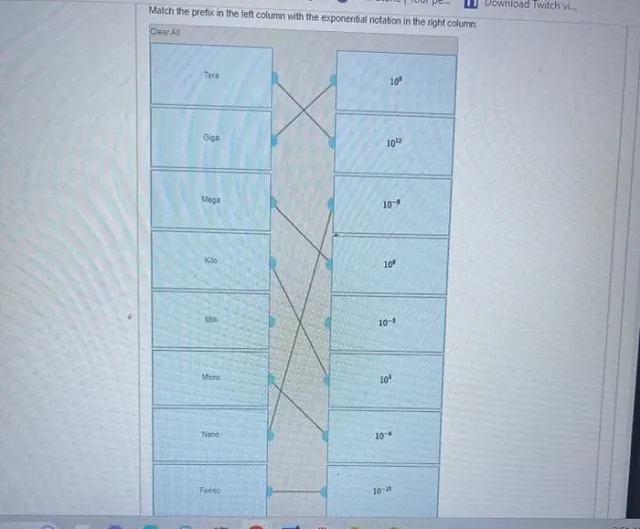Question
Match the prefix in the left column with the exponential notation in the right column
Answer
Step 1
Answer: Here, we would be matching the different prefixes of units to their respective exponential notations.
So for the large units, we have
Tera=1012
Giga=109
Mega=106
Kilo=103
Explanation
These prefixes correspond to larger units of measurement, as compared to the base unit.
Step 2
And for the small units, we have
Milli=10−3
Micro=10−6
Nano=10−9
Femto=10−15
Explanation
These prefixes correspond to smaller units of measurement, as compared to the base unit.
Answer
The given prefixes are matched to their respective exponential notations as
Tera=1012
Giga=109
Mega=106
Kilo=103
Milli=10−3
Micro=10−6
Nano=10−9
Femto=10−15
Table of Contents
Prefix to Exponential Notation: A Matching Exercise
Understanding the relationship between prefixes and exponential notation is essential for anyone working in fields like science, engineering, and mathematics. This knowledge helps in accurately interpreting and expressing large and small numbers, ensuring clear and precise communication. In this article, we will explore the common prefixes used in exponential notation, provide a matching exercise to test your understanding, and explain the significance of these prefixes in various applications.
Introduction to Exponential Notation
Exponential notation is a way of representing numbers that are too large or too small to be conveniently written in decimal form. It uses powers of ten to express these numbers, making them easier to read, write, and understand. For instance, instead of writing 1,000,000, we can write 10610^6106, and instead of writing 0.000001, we can write 10−610^{-6}10−6.
Common Prefixes and Their Exponential Notations
Here are some of the most common prefixes used in exponential notation along with their corresponding powers of ten:
- Kilo (k): 10310^3103 or 1,000
- Mega (M): 10610^6106 or 1,000,000
- Giga (G): 10910^9109 or 1,000,000,000
- Tera (T): 101210^{12}1012 or 1,000,000,000,000
- Milli (m): 10−310^{-3}10−3 or 0.001
- Micro (μ): 10−610^{-6}10−6 or 0.000001
- Nano (n): 10−910^{-9}10−9 or 0.000000001
- Pico (p): 10−1210^{-12}10−12 or 0.000000000001
These prefixes are used to simplify the notation of measurements in various fields. For example, a distance of 0.000001 meters can be expressed as 1 micrometer (1 μm).
Matching Exercise
To solidify your understanding of these prefixes and their corresponding exponential notations, try matching the following prefixes with their exponential notations:
- Kilo (k)
- Mega (M)
- Giga (G)
- Tera (T)
- Milli (m)
- Micro (μ)
- Nano (n)
- Pico (p)
a. 10610^6106
b. 10−310^{-3}10−3
c. 10310^3103
d. 10−610^{-6}10−6
e. 10−1210^{-12}10−12
f. 101210^{12}1012
g. 10910^9109
h. 10−910^{-9}10−9
Answers:
- Kilo (k) – c. 10310^3103
- Mega (M) – a. 10610^6106
- Giga (G) – g. 10910^9109
- Tera (T) – f. 101210^{12}1012
- Milli (m) – b. 10−310^{-3}10−3
- Micro (μ) – d. 10−610^{-6}10−6
- Nano (n) – h. 10−910^{-9}10−9
- Pico (p) – e. 10−1210^{-12}10−12
Importance of Understanding Prefixes and Exponential Notation
Understanding prefixes and their corresponding exponential notations is crucial for several reasons:
- Clarity and Precision: Using the correct prefix helps in conveying the magnitude of a measurement accurately. This is especially important in scientific research, engineering, and technical fields where precision is paramount.
- Simplification: Prefixes simplify the representation of very large or very small numbers, making them easier to read and work with. For example, writing 1 Gigabyte (1 GB) is much simpler than writing 1,000,000,000 bytes.
- Standardization: These prefixes and notations are standardized, meaning they are recognized and understood globally. This standardization helps in maintaining consistency in scientific communication and documentation.
Conclusion
Mastering the relationship between prefixes and exponential notation is an essential skill for anyone involved in scientific, technical, or engineering work. It ensures clear communication, simplifies complex numbers, and adheres to global standards. By practicing and understanding these concepts, you can enhance your ability to work with large and small numbers effectively.
We hope this matching exercise has helped you better understand the common prefixes used in exponential notation. Keep practicing, and soon, these notations will become second nature to you.




